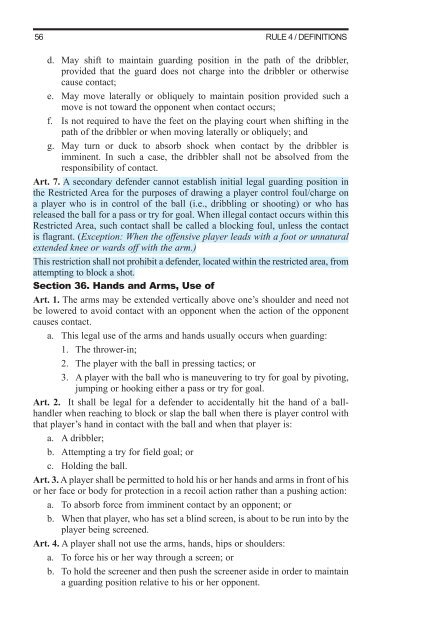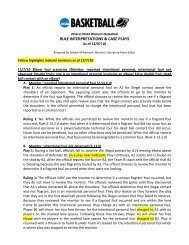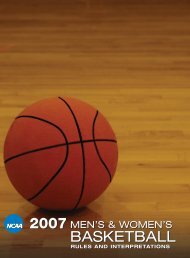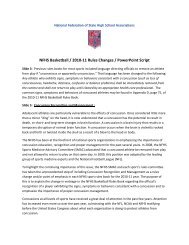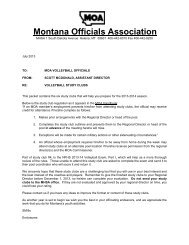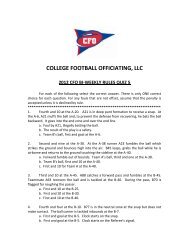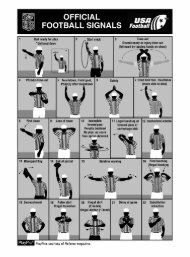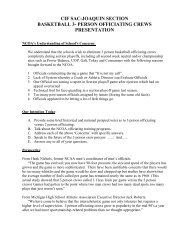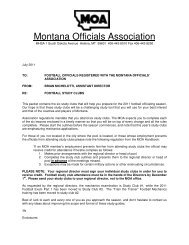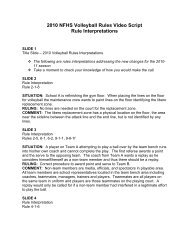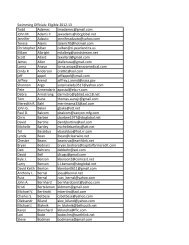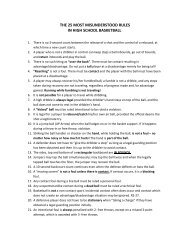2011-12 AND 2012-13 MEN'S AND WOMEN'S RULES - NAIA
2011-12 AND 2012-13 MEN'S AND WOMEN'S RULES - NAIA
2011-12 AND 2012-13 MEN'S AND WOMEN'S RULES - NAIA
Create successful ePaper yourself
Turn your PDF publications into a flip-book with our unique Google optimized e-Paper software.
56<br />
RULE 4 / DEFINITIONS<br />
d. May shift to maintain guarding position in the path of the dribbler,<br />
provided that the guard does not charge into the dribbler or otherwise<br />
cause contact;<br />
e. May move laterally or obliquely to maintain position provided such a<br />
move is not toward the opponent when contact occurs;<br />
f. Is not required to have the feet on the playing court when shifting in the<br />
path of the dribbler or when moving laterally or obliquely; and<br />
g. May turn or duck to absorb shock when contact by the dribbler is<br />
imminent. In such a case, the dribbler shall not be absolved from the<br />
responsibility of contact.<br />
Art. 7. A secondary defender cannot establish initial legal guarding position in<br />
the Restricted Area for the purposes of drawing a player control foul/charge on<br />
a player who is in control of the ball (i.e., dribbling or shooting) or who has<br />
released the ball for a pass or try for goal. When illegal contact occurs within this<br />
Restricted Area, such contact shall be called a blocking foul, unless the contact<br />
is flagrant. (Exception: When the offensive player leads with a foot or unnatural<br />
extended knee or wards off with the arm.)<br />
This restriction shall not prohibit a defender, located within the restricted area, from<br />
attempting to block a shot.<br />
Section 36. Hands and Arms, Use of<br />
Art. 1. The arms may be extended vertically above one’s shoulder and need not<br />
be lowered to avoid contact with an opponent when the action of the opponent<br />
causes contact.<br />
a. This legal use of the arms and hands usually occurs when guarding:<br />
1. The thrower-in;<br />
2. The player with the ball in pressing tactics; or<br />
3. A player with the ball who is maneuvering to try for goal by pivoting,<br />
jumping or hooking either a pass or try for goal.<br />
Art. 2. It shall be legal for a defender to accidentally hit the hand of a ballhandler<br />
when reaching to block or slap the ball when there is player control with<br />
that player’s hand in contact with the ball and when that player is:<br />
a. A dribbler;<br />
b. Attempting a try for field goal; or<br />
c. Holding the ball.<br />
Art. 3. A player shall be permitted to hold his or her hands and arms in front of his<br />
or her face or body for protection in a recoil action rather than a pushing action:<br />
a. To absorb force from imminent contact by an opponent; or<br />
b. When that player, who has set a blind screen, is about to be run into by the<br />
player being screened.<br />
Art. 4. A player shall not use the arms, hands, hips or shoulders:<br />
a. To force his or her way through a screen; or<br />
b. To hold the screener and then push the screener aside in order to maintain<br />
a guarding position relative to his or her opponent.


